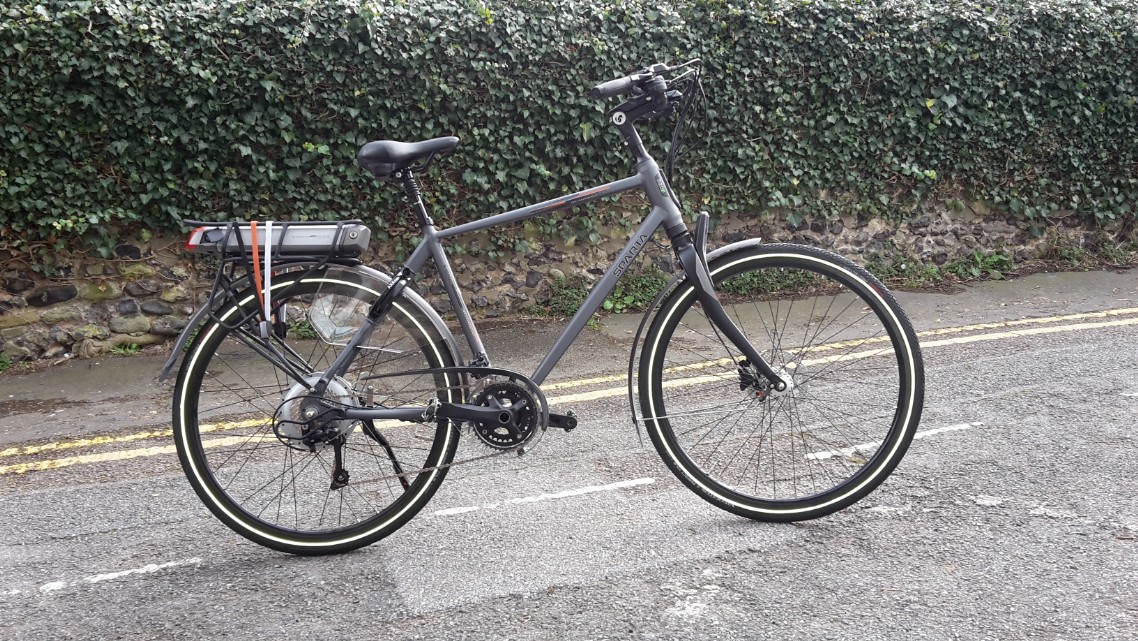My new E-bike - Potterers Cycling Club
The Potterers Cycling Club
Pottering in Kent for 50 years !
The Potterers Cycling Club
Pottering in Kent since 1971




Words > Articles
My First Electric Bike (photo below)
Sue, my wife, wrote an article for Pottering Around last year. She mentioned her new electric bike and some of our adventures in East Flanders. Sue bought her Sparta ebike in April 2017 from a local dealer near the campsite where our static caravan is situated. She had spent a lot of time over the winter on the internet researching ebikes before deciding on her Sparta M8i. She is very pleased with it and uses it often when in Belgium.
I persuaded her to let me give it a proper test with some proper hills in East Kent over the coming winter whilst our caravan was hibernating. Some of you may have seen her ebike at some of the “meets”. I think I used it on five or six occasions. And I was impressed.
Briefly, it is a step-through, mid-motor (motor at bottom bracket) frame. Eight speed hub gear in back wheel. Sturdy back rack within which sits the battery. It was also the smallest sized frame in that model, 48cm, and I don’t know what measurement that refers to.
I had to raise the seat 5cm, after tippexing the post. That was the only adjustment I made. The riding position on the small frame was very upright with a sense that you got into the bike rather than mounted it, as the handlebars seemed to surround me. In addition, the BB centre was about 50mm higher than my Raleigh, and the bars situated a lot higher than the seat. One website referred to a “traditional Dutch riding position”. I found it extremely comfortable, helped by a lady’s saddle (can I say that?) and a powerful electric motor that made light of Dover’s notorious topography and any strong headwinds. Dover to the “meet” at Reculver and back was easily in its stride. However, her bike looking so obviously electrically-assisted, I felt I had to pretend to be exerting myself whilst cycling up Castle Hill. Rolling the shoulders and puffing the cheeks….
Suffice to say that my experiences riding her ebike decided me. I wanted one. In fact I deserved one. When I think of all those cycling days I have missed because I awoke feeling less than 100%. Why do Sunday mornings come after Saturday nights? Then, the thought of the steep hills out of Dover. I switched on the computer and entered “shopping for electric bikes” into the Google search box…..
An hour later I realised that the plethora of choice was doing my head in. So, I made a simple decision. Keep with the devil you know and, in this case, it was Sparta. A well-established Dutch make with a long history and a good reputation. I looked at their website and decided on the model. Not for me a step-through. Besides, when you stop to look at the map the bike falls over. No, I’m still young enough to get my leg over a cross bar.
So, my decision made, I looked at the London Sparta dealer’s website where my choice was described as having “regenerative braking”. I was excited, what with all the downhills hereabouts. But on the Dutch website it wasn’t mentioned. Intrigued, I dashed off an email to both countries. Categorically yes said London. Categorically not said Holland. Needless to say, I believed the Dutch but felt deflated. (Later on, you’ll discover why I think they’re both wrong.)
I ordered my Sparta R20i from Hollandbikeshop.com and chose to have the largest battery just like Sue had on hers. The “R” denotes the motor position. F, M or R. The “20” is the number of gears. The “i” denotes the “ion” control system. It arrived in a massive cardboard five-sided box (wheels poking out the bottom). It was worth the wait. I had to fit the provided pedals, rotate the bars 90 and adjust the seat. The tyres and battery arrived full of air and electrons. I made a couple of circuits of our local carpark and was happy. Especially happy that the frame was not too small.
I had been rather worried as to whether I had ordered the correct size frame. I thought that whatever system Sparta used to measure frame size on Sue’s bike would apply to mine. Sue’s frame was 48cm. Plus the 5cm I had raised her seat came to 53cm. But this was the smallest size in my chosen model and I’m 5’9” in old money and always thought my size average, in so many ways.
Briefly: My frame, a sloping diamond, is of steel and beautifully welded and finished. The motor is in the back wheel and the battery, like Sue’s, slides into the rear carrier. This makes “wheelies” possible but rules out “stoppies”, even with the very powerful disc brakes. It has a 10-speed rear block a double chainring and Disraeli Gears (I still have the LP). The control system hardware is the same as Sue’s but there is one significant difference in the software menu – “Automatic charging”.
Regenerative Braking v Automatic Charging? I admit that I haven’t bothered to look up the definition of RB, (A follow up article about this, maybe, Colin?) but I assume that it has a significant braking effect. AC does not. Basically, when I’m freewheeling, the motor turns into a generator, with consequent drag, and puts some charge back into the battery. The battery must be below 85% for this to happen, AND, strangely, the speed must be BELOW a certain threshold for it to begin recharging. The braking effect is about as much as having a brake block rubbing on the rim.
I have used it on three Potterers “meets” to date and have fine-tuned it to my riding position and my preferences. Front mudguard - off and “Crud-catcher”, attached to downtube, - on. A “Mirracycle” mirror fitted to the bar end. A pair of panniers fitted to cover the battery up. I love it. It makes me feel I have the same level of fitness that I had on the CTC rides in my thirties. AND, to the untrained eye, it looks just like an ordinary bike now.
So, I shan’t be pretending on Castle Hill anymore….
Pete Smith






